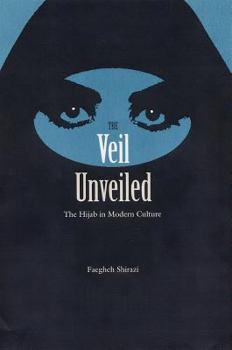The Veil Unveiled: The Hijab in Modern Culture
Select Format
Select Condition 
Book Overview
"An original contribution to a subject which is currently of much interest to the world at large, East or West, and has an important bearing on the position of women in the societies in which veiling is practiced."--The Middle East Journal "Highly recommended. . . . It draws on and contributes to current feminist theorizing in Middle East women's studies and in broader feminist academic circles."--International Journal of Middle East Studies "A welcome contribution to Middle Eastern and women s studies, providing an innovating approach and research to a highly controversial issue in gender politics."--Digest of Middle East Studies An insightful and provocative book. . . . It] leads to a better understanding of the veil and a debunking of current cliches. Farzaneh Milani, University of Virginia Illustrated with photographs, drawings, and cartoons gathered from popular culture, this provocative book demonstrates that the veil, the garment known in Islamic cultures as the hijab, holds within its folds a semantic versatility that goes far beyond current cliches and homogenous representations. Whether seen as erotic or romantic, a symbol of oppression or a sign of piety, modesty, or purity, the veil carries thousands of years of religious, sexual, social, and political significance. Using examples from both the East and West including Persian poetry, American erotica, Iranian and Indian films, and government-sanctioned posters Faegheh Shirazi shows that the veil has become a ubiquitous symbol, utilized as a profitable marketing tool for diverse enterprises, from Penthouse magazine to Saudi advertising companies. She argues that perceptions of the veil change with the cultural context of its use as well as over time: in a Hindi movie the veil draws in the male gaze, in an Iranian movie it denies it; photographs of veiled women in Playboy aim to titillate a principally male audience, while cartoons of veiled women in the same magazine mock and ridicule Muslim society. Shirazi concludes that the practice of veiling, encompassing an amazingly rich array of meanings, has often become a screen upon which different people in different cultures project their dreams and nightmares. Faegheh Shirazi is associate professor of Middle Eastern languages and cultures in the Islamic Studies Program at the University of Texas, Austin. She is the author of several book chapters and articles on issues related to women in Islam in numerous publications, including Critique and Journal for Critical Studies of the Middle East."
Format:Hardcover
Language:English
ISBN:0813020840
ISBN13:9780813020846
Release Date:June 2001
Publisher:University Press of Florida
Length:240 Pages
Weight:1.00 lbs.
Dimensions:0.9" x 6.0" x 9.0"
Customer Reviews
2 ratings
symbolism of hijab
Published by Thriftbooks.com User , 18 years ago
pretty interesting read even when I disagreed with the conclusions like e-communication equals conquering of veiled women in the advertising section. Covers advertising, american erotica, cinema, iranian politics... worth reading
If You're Curious About Why Women Wear Veils
Published by Thriftbooks.com User , 23 years ago
If you're curious about why women wear veils, while so many women of the world are, so to speak, unveiling to the point of nudity, then you might find this book interesting. The author examines the veil from a wide perspective that encompasses the historical, political, cultural, as well as religious domains, and in a variety of contexts that includes film, advertising, literary, and erotica. It is noted in the introduction that the veil's history dates back thousands of years to an Assyrian legal text, when veiling was restricted to respectable women and prohibited for prostitutes. In Assyrian, Greco-Roman, and Byzantine empires veiling was a mark of prestige and status. The author, Faegheh Shirazi, who is a professor at the University of Texas at Austin, specializes in textiles and material cultures studies. She shows, through a series of a half dozen chapters, the immense versatility of meaning that the veil can have, depending on the context of its use. In Iranian cinema, for example, its use means adhering to the strictures of Islam, which forbids the erotic, whereas in Indian cinema it's meant to be titillating and erotic. In a chapter entitled "Veiled Images in American Erotica," cartoons from the pages of "Playboy," "Penthouse," and "Hustler" are examined. A chapter on advertising shows how the veil is used to sell automobiles, perfume, cigarettes, computers, and sanitary napkins, among dozens of other products. There are chapters covering military, political, and literary aspects as well as film. In Muslim cultures the veil is used to prevent "fitna," defined as the chaos caused by women's sexuality. If this is true, then the case might be made that a good part of the world is in total chaos. Regardless of your viewpoint, the book is thought provoking for anyone interested in human beings and culture.






